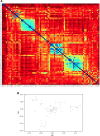Visualization of Genome Diversity in German Shepherd Dogs
- PMID: 26884680
- PMCID: PMC4750897
- DOI: 10.4137/BBI.S30524
Visualization of Genome Diversity in German Shepherd Dogs
Abstract
A loss of genetic diversity may lead to increased disease risks in subpopulations of dogs. The canine breed structure has contributed to relatively small effective population size in many breeds and can limit the options for selective breeding strategies to maintain diversity. With the completion of the canine genome sequencing project, and the subsequent reduction in the cost of genotyping on a genomic scale, evaluating diversity in dogs has become much more accurate and accessible. This provides a potential tool for advising dog breeders and developing breeding programs within a breed. A challenge in doing this is to present complex relationship data in a form that can be readily utilized. Here, we demonstrate the use of a pipeline, known as NetView, to visualize the network of relationships in a subpopulation of German Shepherd Dogs.
Keywords: German Shepherd Dog; diversity; genome.
Figures


References
-
- Pedersen N, Liu H, Theilen G, Sacks B. The effects of dog breed development on genetic diversity and the relative influences of performance and conformation breeding. J Anim Breed Genet. 2013;130(3):236–48. - PubMed
-
- Bateson P, Nicholas FW, Sargan DR, Wade CM. Analysis of the canine genome and canine health: bridging a gap. Vet J. 2013;196(1):1–3. - PubMed
LinkOut - more resources
Full Text Sources

